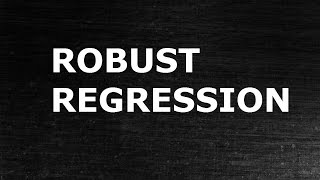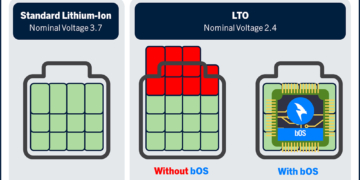-
Table of Contents
- Introduction
- What is Robust Regression and How Does it Differ from Traditional Regression?
- How to Use Robust Regression to Improve Machine Learning Model Performance
- Understanding the Role of Robust Regression in Automated Machine Learning
- Analyzing the Impact of Robust Regression on Model Performance
- The Benefits of Robust Regression for Feature Selection
- How Robust Regression Can Help Improve Model Generalization
- Understanding the Limitations of Robust Regression for Machine Learning Modeling
- The Benefits of Robust Regression for Time Series Data
- Analyzing the Impact of Robust Regression on Model Accuracy
- How Robust Regression Can Help Improve Model Interpretability
- The Advantages of Robust Regression for High-Dimensional Data
- Comparing Robust Regression to Other Outlier Detection Methods
- Understanding the Different Types of Robust Regression Techniques
- How Robust Regression Can Help Reduce Overfitting in Machine Learning Models
- The Benefits of Robust Regression for Outlier Detection
- Conclusion
“Robust Regression: Get the Most Out of Your Machine Learning Models, Even in the Presence of Outliers!”
Introduction
Robust regression is a technique for outlier resistant machine learning modeling. It is a form of regression analysis that is robust to outliers, meaning that it is less affected by outliers than traditional regression methods. Robust regression is used to identify and remove outliers from a dataset, and then use the remaining data to build a more accurate model. It is a powerful tool for data scientists and machine learning practitioners, as it can help them build more accurate models and reduce the risk of overfitting. Robust regression can also be used to identify influential observations in a dataset, which can be used to improve the accuracy of the model.
What is Robust Regression and How Does it Differ from Traditional Regression?
Robust regression is a type of regression analysis that is used to analyze data sets that contain outliers or extreme values. It is designed to provide more reliable estimates than traditional regression methods, which can be adversely affected by outliers.
Unlike traditional regression methods, robust regression uses a different approach to estimate the parameters of the model. Instead of minimizing the sum of squared errors, robust regression minimizes the sum of absolute errors. This approach is more resistant to outliers, as it does not give them as much weight in the estimation process.
Robust regression also uses different techniques to identify outliers. Traditional regression methods rely on the assumption that the data is normally distributed, which can lead to incorrect identification of outliers. Robust regression uses techniques such as the median absolute deviation to identify outliers, which is more reliable.
Overall, robust regression is a more reliable method of regression analysis than traditional regression methods. It is better able to identify outliers and is more resistant to their influence on the estimation process.
How to Use Robust Regression to Improve Machine Learning Model Performance
Robust regression is a type of regression analysis that is used to analyze data sets that contain outliers or extreme values. It is a powerful tool for improving the performance of machine learning models.
Robust regression is based on the idea of minimizing the influence of outliers on the regression model. It does this by using a different loss function than traditional regression models. Instead of minimizing the sum of squared errors, robust regression minimizes the sum of absolute errors. This means that outliers have less of an influence on the model, as they are not weighted as heavily as in traditional regression models.
Robust regression can be used to improve the performance of machine learning models in a number of ways. First, it can help to reduce the effect of outliers on the model. This can help to improve the accuracy of the model, as outliers can have a significant impact on the results. Second, robust regression can help to reduce the variance of the model, which can help to improve the generalizability of the model. Finally, robust regression can help to reduce the computational complexity of the model, as it requires fewer parameters to be estimated.
In order to use robust regression to improve the performance of a machine learning model, it is important to first identify any potential outliers in the data set. Once these outliers have been identified, they can be removed from the data set or their influence can be minimized using robust regression. After this, the model can be trained using robust regression instead of traditional regression.
Robust regression is a powerful tool for improving the performance of machine learning models. By minimizing the influence of outliers on the model, it can help to improve the accuracy, reduce the variance, and reduce the computational complexity of the model.
Understanding the Role of Robust Regression in Automated Machine Learning
Robust regression is an important tool in automated machine learning (AutoML). It is a type of regression analysis that is designed to be more resilient to outliers and other data points that may be considered “noisy” or “irregular”. This makes it a valuable tool for AutoML, as it can help to reduce the impact of outliers on the model’s performance.
Robust regression works by using a different loss function than traditional regression models. Instead of using the least squares method, which is sensitive to outliers, robust regression uses a different loss function that is more resilient to outliers. This loss function is known as the Huber loss function, and it is designed to reduce the impact of outliers on the model’s performance.
Robust regression is also useful for AutoML because it can help to reduce the amount of data pre-processing that is required. Traditional regression models require data to be pre-processed in order to remove outliers and other noisy data points. Robust regression, on the other hand, can handle these data points without the need for pre-processing. This can save time and resources, as well as improve the accuracy of the model.
Finally, robust regression can also help to improve the accuracy of AutoML models. By reducing the impact of outliers, robust regression can help to improve the accuracy of the model by reducing the amount of noise in the data. This can lead to more accurate predictions and better overall performance.
In summary, robust regression is an important tool in automated machine learning. It is designed to be more resilient to outliers and other noisy data points, which can help to reduce the amount of data pre-processing that is required. Additionally, it can help to improve the accuracy of the model by reducing the amount of noise in the data. For these reasons, robust regression is an invaluable tool for AutoML.
Analyzing the Impact of Robust Regression on Model Performance
Robust regression is a statistical technique that is used to analyze data that contains outliers or extreme values. It is a form of regression analysis that is designed to be more resistant to the effects of outliers than traditional linear regression. The goal of robust regression is to produce a model that is more accurate and reliable than traditional linear regression.
Robust regression has been shown to improve the performance of models in a variety of situations. For example, it can be used to improve the accuracy of predictions in cases where the data contains outliers or extreme values. It can also be used to reduce the effects of multicollinearity, which is a situation where two or more predictor variables are highly correlated. Additionally, robust regression can be used to reduce the effects of heteroscedasticity, which is a situation where the variance of the errors is not constant across the range of the predictor variables.
Robust regression can also be used to improve the interpretability of models. By reducing the effects of outliers and multicollinearity, robust regression can help to make the results of a model more interpretable. This can be especially useful in cases where the data contains a large number of predictor variables.
Overall, robust regression can be a powerful tool for improving the performance of models. It can be used to reduce the effects of outliers, multicollinearity, and heteroscedasticity, as well as to improve the interpretability of models. As such, it is an important technique for data scientists to be familiar with.
The Benefits of Robust Regression for Feature Selection
Robust regression is a powerful tool for feature selection, as it can identify the most important features in a dataset while minimizing the effects of outliers. This is especially useful in datasets with a large number of features, as it can help to reduce the complexity of the model and improve its accuracy.
Robust regression is a form of regression analysis that is resistant to outliers. It uses a technique called “robust estimation” to identify the most important features in a dataset. This technique is based on the idea that the most important features should be the ones that have the most influence on the outcome of the model. Robust estimation uses a technique called “least absolute deviation” to identify the most influential features. This technique is based on the idea that the most influential features should be the ones that have the least amount of deviation from the mean.
Robust regression is also useful for feature selection because it can help to reduce the complexity of the model. By identifying the most important features, it can help to reduce the number of features that need to be included in the model. This can help to reduce the complexity of the model and improve its accuracy.
Finally, robust regression can also help to reduce the effects of outliers. By identifying the most important features, it can help to reduce the influence of outliers on the model. This can help to improve the accuracy of the model and reduce the risk of overfitting.
Overall, robust regression is a powerful tool for feature selection. It can help to reduce the complexity of the model and improve its accuracy by identifying the most important features and reducing the influence of outliers. This can help to improve the performance of the model and reduce the risk of overfitting.
How Robust Regression Can Help Improve Model Generalization
Robust regression is a type of regression analysis that is used to analyze data sets that contain outliers or extreme values. It is a form of regression analysis that is more resistant to outliers than traditional linear regression. This makes it a useful tool for improving model generalization, as it can help to reduce the influence of outliers on the model.
Robust regression works by using a different loss function than traditional linear regression. Instead of minimizing the sum of squared errors, robust regression minimizes the sum of absolute errors. This means that outliers have less of an influence on the model, as they are not weighted as heavily as they would be in traditional linear regression.
Robust regression can also be used to identify outliers in a data set. By using robust regression, it is possible to identify points that are significantly different from the rest of the data. This can be useful for identifying data points that may be skewing the results of a model.
Overall, robust regression can be a useful tool for improving model generalization. By reducing the influence of outliers on the model, robust regression can help to ensure that the model is more accurate and reliable. Additionally, robust regression can be used to identify outliers in a data set, which can help to improve the accuracy of the model.
Understanding the Limitations of Robust Regression for Machine Learning Modeling
Robust regression is a powerful tool for machine learning modeling, but it is important to understand its limitations. Robust regression is a type of regression analysis that is designed to be resistant to outliers, meaning that it is less affected by extreme values in the data. This makes it a useful tool for dealing with datasets that contain outliers, as it can help to reduce the impact of these outliers on the model.
However, robust regression is not a panacea for dealing with outliers. It is important to remember that robust regression is still a linear model, and so it is limited in its ability to capture non-linear relationships in the data. Additionally, robust regression is not designed to detect outliers, and so it is important to identify and remove any outliers from the dataset before applying robust regression.
Finally, robust regression is not suitable for all types of datasets. It is best suited for datasets that contain a small number of outliers, as it is not designed to handle large numbers of outliers. Additionally, robust regression is not suitable for datasets with a large number of variables, as it can be difficult to interpret the results of the model.
In summary, robust regression is a powerful tool for machine learning modeling, but it is important to understand its limitations. It is best suited for datasets that contain a small number of outliers, and it is not suitable for datasets with a large number of variables. Additionally, it is important to identify and remove any outliers from the dataset before applying robust regression.
The Benefits of Robust Regression for Time Series Data
Robust regression is a powerful tool for analyzing time series data. It is a form of regression analysis that is designed to be more resilient to outliers and other forms of data noise. This makes it an ideal choice for analyzing time series data, which often contains outliers and other irregularities.
Robust regression is based on the concept of minimizing the influence of outliers on the regression model. It does this by using a different loss function than traditional regression models. This loss function is designed to be more resistant to outliers, meaning that it will not be as heavily influenced by them. This makes it more reliable for analyzing time series data, which often contains outliers.
Another benefit of robust regression is that it is more resistant to multicollinearity. Multicollinearity occurs when two or more variables are highly correlated, which can lead to inaccurate results. Robust regression is designed to be more resistant to this problem, making it a better choice for analyzing time series data.
Finally, robust regression is more efficient than traditional regression models. It is able to fit a model to the data more quickly, which can be beneficial when analyzing large datasets. This makes it a great choice for analyzing time series data, which often contains large amounts of data.
Overall, robust regression is a powerful tool for analyzing time series data. It is more resistant to outliers and multicollinearity and is more efficient than traditional regression models. This makes it an ideal choice for analyzing time series data, which often contains outliers and other irregularities.
Analyzing the Impact of Robust Regression on Model Accuracy
Robust regression is a statistical technique that is used to analyze data that contains outliers or extreme values. It is a form of regression analysis that is designed to be more resilient to the presence of outliers in the data. The goal of robust regression is to produce a model that is more accurate and reliable than traditional regression models.
Robust regression is based on the idea that the data should be analyzed in a way that minimizes the influence of outliers. This is done by using a different type of loss function than traditional regression models. The loss function used in robust regression is designed to be more resistant to the presence of outliers. This means that the model will be less affected by extreme values in the data.
The impact of robust regression on model accuracy can be significant. Robust regression models are more resistant to the presence of outliers, which can lead to more accurate predictions. This is because the model is less likely to be influenced by extreme values in the data. Additionally, robust regression models are more reliable than traditional regression models. This is because the model is less likely to be affected by outliers, which can lead to more consistent results.
Overall, robust regression can have a positive impact on model accuracy. By using a different type of loss function, robust regression models are more resistant to the presence of outliers. This can lead to more accurate predictions and more reliable results. As such, robust regression can be a useful tool for improving the accuracy of regression models.
How Robust Regression Can Help Improve Model Interpretability
Robust regression is a type of regression analysis that is used to analyze data sets that contain outliers or extreme values. It is a more robust form of linear regression that is less sensitive to outliers than traditional linear regression. This makes it a useful tool for improving model interpretability, as it can help to identify and remove outliers that may be skewing the results of a linear regression model.
Robust regression can also help to improve the accuracy of a model by reducing the influence of outliers on the model’s predictions. By removing outliers, the model can focus on the data points that are more representative of the underlying data set, resulting in more accurate predictions.
Robust regression can also help to improve the interpretability of a model by providing more insight into the relationships between the variables in the data set. By removing outliers, the model can focus on the relationships between the variables that are more representative of the underlying data set, resulting in a more interpretable model.
Finally, robust regression can help to improve the stability of a model by reducing the influence of outliers on the model’s predictions. By removing outliers, the model can focus on the data points that are more representative of the underlying data set, resulting in more stable predictions.
Overall, robust regression can be a useful tool for improving model interpretability, accuracy, and stability. By removing outliers, the model can focus on the data points that are more representative of the underlying data set, resulting in more interpretable, accurate, and stable predictions.
The Advantages of Robust Regression for High-Dimensional Data
Robust regression is a powerful tool for analyzing high-dimensional data. It is a form of regression analysis that is designed to be resistant to outliers and other sources of noise in the data. This makes it an ideal choice for analyzing data sets with a large number of variables, as it can help to reduce the impact of outliers and other sources of noise.
Robust regression is based on the idea of minimizing the sum of absolute residuals, rather than the sum of squared residuals. This means that it is less sensitive to outliers, as outliers will have less of an impact on the overall result. This makes it a good choice for high-dimensional data sets, as it can help to reduce the impact of outliers and other sources of noise.
Robust regression also has the advantage of being able to handle missing data. It can use a variety of techniques to fill in missing values, such as imputation or interpolation. This makes it a good choice for data sets with a large number of missing values, as it can help to reduce the impact of missing data on the overall result.
Finally, robust regression is also able to handle multicollinearity, which is a common problem in high-dimensional data sets. Multicollinearity occurs when two or more variables are highly correlated, which can lead to inaccurate results. Robust regression can help to reduce the impact of multicollinearity by using techniques such as ridge regression or lasso regression.
Overall, robust regression is a powerful tool for analyzing high-dimensional data sets. It is resistant to outliers and other sources of noise, can handle missing data, and can reduce the impact of multicollinearity. This makes it an ideal choice for analyzing high-dimensional data sets.
Comparing Robust Regression to Other Outlier Detection Methods
Robust regression is a type of regression analysis that is used to analyze data sets that contain outliers. It is a form of regression analysis that is resistant to outliers, meaning that it is less affected by extreme values in the data set. This makes it a useful tool for analyzing data sets that contain outliers, as it can provide more accurate results than other methods of outlier detection.
Robust regression is different from other outlier detection methods in that it does not rely on the assumption that the data is normally distributed. Instead, it uses a technique called robust estimation, which is based on the median and interquartile range of the data. This allows it to be more resistant to outliers, as it is not affected by extreme values in the data set.
In comparison to other outlier detection methods, robust regression is more accurate and reliable. It is also more efficient, as it does not require the data to be normally distributed. Additionally, it is less affected by outliers, meaning that it can provide more accurate results.
Overall, robust regression is a useful tool for analyzing data sets that contain outliers. It is more accurate and reliable than other outlier detection methods, and it is less affected by extreme values in the data set. As such, it is a valuable tool for analyzing data sets that contain outliers.
Understanding the Different Types of Robust Regression Techniques
Robust regression is a type of regression analysis that is used to analyze data sets that contain outliers or extreme values. It is designed to provide more reliable results than traditional linear regression methods. Robust regression techniques are used to reduce the influence of outliers on the regression model and to improve the accuracy of the model.
There are several types of robust regression techniques, each with its own advantages and disadvantages. The most common types of robust regression techniques are:
1. Least Absolute Deviations (LAD): This technique minimizes the sum of the absolute values of the residuals. It is a robust technique that is resistant to outliers and can be used to estimate parameters in the presence of outliers.
2. Least Squares (LS): This technique minimizes the sum of the squared residuals. It is the most commonly used technique and is the basis for many other regression techniques.
3. Robust Regression (RR): This technique is designed to reduce the influence of outliers on the regression model. It uses a weighting scheme to reduce the influence of outliers and to improve the accuracy of the model.
4. Iteratively Reweighted Least Squares (IRLS): This technique is an iterative process that reweights the data points based on their residuals. It is a robust technique that is resistant to outliers and can be used to estimate parameters in the presence of outliers.
5. M-Estimators: This technique is a generalization of the least squares technique. It uses a weighting scheme to reduce the influence of outliers and to improve the accuracy of the model.
Robust regression techniques are useful for analyzing data sets that contain outliers or extreme values. They can be used to reduce the influence of outliers on the regression model and to improve the accuracy of the model. Each technique has its own advantages and disadvantages, so it is important to choose the technique that best fits the data set and the analysis goals.
How Robust Regression Can Help Reduce Overfitting in Machine Learning Models
Overfitting is a common problem in machine learning models, where the model is too closely fitted to the training data, resulting in poor generalization performance on unseen data. Robust regression is a technique that can help reduce overfitting in machine learning models.
Robust regression is a form of regression analysis that is designed to be more resilient to outliers and other forms of noise in the data. It is based on the idea of minimizing the sum of absolute errors (L1 norm) instead of the sum of squared errors (L2 norm). This makes the model more robust to outliers, as it is less sensitive to them.
Robust regression can be used to reduce overfitting in machine learning models by introducing a penalty for outliers. This penalty encourages the model to be less sensitive to outliers, which can help reduce overfitting. Additionally, robust regression can help reduce the variance of the model, which can also help reduce overfitting.
Robust regression can also be used to improve the accuracy of the model by reducing the bias. This is because robust regression is less sensitive to outliers, which can help reduce the bias of the model.
Overall, robust regression is a useful technique for reducing overfitting in machine learning models. It can help reduce the variance and bias of the model, as well as introduce a penalty for outliers, which can help reduce overfitting.
The Benefits of Robust Regression for Outlier Detection
Robust regression is a powerful tool for outlier detection. It is a form of regression analysis that is designed to be resistant to outliers, which are data points that are significantly different from the rest of the data. Robust regression is particularly useful for detecting outliers in datasets that contain a large number of observations.
Robust regression is based on the idea of minimizing the influence of outliers on the regression model. It does this by using a different loss function than traditional regression models. This loss function is designed to be more resistant to outliers, meaning that it will not be as heavily influenced by them. This makes robust regression more reliable for outlier detection than traditional regression models.
Robust regression also has the advantage of being able to detect outliers in datasets with a large number of observations. Traditional regression models can become overwhelmed by the sheer number of observations, making it difficult to detect outliers. Robust regression, however, is able to handle large datasets more effectively, making it easier to detect outliers.
Finally, robust regression is also more efficient than traditional regression models. It is able to detect outliers more quickly and accurately, meaning that it can be used to analyze datasets more quickly and efficiently. This makes it an ideal tool for outlier detection in large datasets.
Overall, robust regression is a powerful tool for outlier detection. It is able to detect outliers more reliably than traditional regression models, and it is able to handle large datasets more effectively. It is also more efficient than traditional regression models, making it an ideal tool for outlier detection in large datasets.
Conclusion
Robust regression is a powerful technique for outlier resistant machine learning modeling. It is a useful tool for dealing with outliers in data sets, as it is able to identify and remove outliers while still providing accurate predictions. Robust regression is also relatively easy to implement, making it a great choice for data scientists looking to build robust machine learning models.














